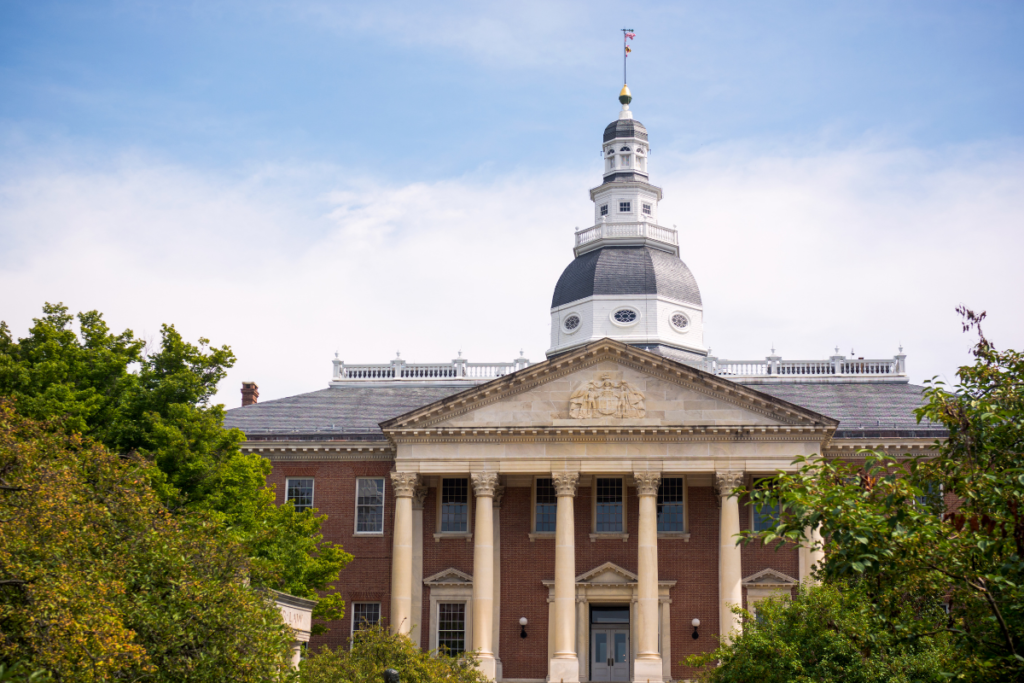The 2022 Maryland General Assembly Session will be remembered for Senate Bill 528 – The Climate Solutions Now Act, a sprawling, 100-page climate bill which establishes an emissions and energy standard for existing buildings.
 The headline requirements for buildings are a 20% reduction in direct building emissions by 2030 and net-zero direct emissions by 2040. But the compromise bill sets out a cautious implementation schedule that includes more than two dozen studies and reports related to building technologies, readiness of the electric grid, subsidies for building retrofits, and economic impacts on small businesses, manufacturing and overburdened communities. Exemptions are included for historic buildings, commercial kitchens, laboratories, manufacturing and other special uses. An alternative-compliance fee, based on the social cost of carbon, can be paid instead of conversion. The net-zero by 2040 requirement sunsets in 2029 and must be reauthorized by the General Assembly to remain in effect.
The headline requirements for buildings are a 20% reduction in direct building emissions by 2030 and net-zero direct emissions by 2040. But the compromise bill sets out a cautious implementation schedule that includes more than two dozen studies and reports related to building technologies, readiness of the electric grid, subsidies for building retrofits, and economic impacts on small businesses, manufacturing and overburdened communities. Exemptions are included for historic buildings, commercial kitchens, laboratories, manufacturing and other special uses. An alternative-compliance fee, based on the social cost of carbon, can be paid instead of conversion. The net-zero by 2040 requirement sunsets in 2029 and must be reauthorized by the General Assembly to remain in effect.
The bill expresses the intent of the legislature to broaden the electrification of new and existing buildings but does not change the requirements for new construction. Requirements that all space and water heating loads in new construction were to be served by electric equipment and separate provisions that would have required electric-ready construction beginning in 2024 were removed. The Maryland Codes Administration is charged with studying and reporting on cost-effective decarbonization techniques and technologies for new and existing buildings.
The General Assembly asserted its primary policy-making role by removing language from the bill that expressly authorized local governments to adopt more stringent building performance standards. Bills requiring that local governments adopt their own climate action plans and authorizing local adoption of penalties of up to $10 per square foot for non-compliant buildings, were killed in committee.
Early in the session the bill was presented as a done deal but began to take on much different contours as raw climate ambition encountered some of the physical and financial barriers to rapid decarbonization of buildings. In an informational letter to legislators, The Maryland Public Service Commission warned of a gas price death spiral caused by the sudden shift of operating costs onto customers who remain on the gas system as commercial buildings electrify and leave. Maryland’s publicly owned electric utilities advised caution and raised questions about how quickly their distribution infrastructure could be expected to accommodate increased demand from electrifying building heat and hot water. The final version of the bill charges the Maryland Public Service Commission with studying and reporting on grid reliability and readiness.
Debate on the bill revealed wide gaps in understanding and broad disagreement within the industry about the feasibility of rapid decarbonization of existing buildings. A memo from AIA’s Maryland Chapter advised legislators that “replacing gas systems with electric does not significantly increase the cost of life cycle system replacements.” Statements like this from AIA and other advocacy groups lacked nuance, homogenized outcomes and understated variations in costs across different building types. This perpetuated misunderstandings about the challenges of an energy transition in buildings and made it more difficult for legislators to focus on the supportive policies necessary to accelerate the pace. Perhaps unconvinced, the Assembly ordered multiple studies on technical issues and feasibility that will improve the learning rate and provide future opportunities to improve implementation.